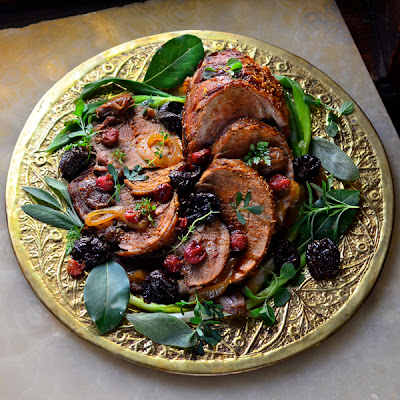 |
| Strasbourg/Argentina 1644 |
“An early sign of fall in the Alsatian wine villages that spread out from the Rhine River to the crest of the Vosges Mountains is a prominent market sign announcing: Nouvelle Choucroute. This means the season's first batch of sauerkraut, still a bit crunchy and with just a hint of acidity, is in the market, ready to be garnished, then roasted with an array of salted and smoked pork, lean bacon, and perhaps a half dozen different sausages, all to be washed down with plenty of crisp and chilled local white Riesling.” So said Patricia Wells In a 1982 NYT’s article.
It is that time of year when we begin to enjoy clean cool air, simmering pots and hearth fires –– the perfect season for Alsatian cuisine. Alsace is known for hearty, cold-weather-fortifying foods like choucroute, flammekueche (an onion, bacon and fresh cheese tart), chicken with Riesling, prunes and cabbage, fleishschneke (meat on noodle dough rolled and sliced in a broth), and of course Quiche Lorraine and Strasbourg goose liver paté (tinned Strasbourg paté was the first foie gras I ever tasted –– it was supposedly invented around 1780 by Jean-Pierre Claus in Strasbourg).
I love the picturesque villages and towns of Alsace but must admit, Alsace’s capitol, the very ancient Roman city of Argentina, now Strasbourg, is a favorite of mine – not just because it saw the birth of Gutenberg’s printing press and the French anthem Les Marseillaise. It contains Strasbourg Cathedral –– the tallest building in the world from the 17th to the 19th century, as well as other marvelous streets and buildings, most especially the 15th century Kamerzell Altehaus –– I love all its swoops and droops and carvey bits. The city is a UNESCO World Heritage site full of half-timbered houses, wooden bridges and canals.
 |
Kammerzell Altehaus, Strasbourg |
 |
| Sorcerer’s Apprentice, Barth Illustration |
When I was tasked with making a dish using things that were pickled as my Creative Cooking Crew challenge this month, things Alsatian came to mind, yes, but I was also inspired by a D'Artagnan frozen duck leg hurtling from my freezer onto my foot when I opened the door. Choucroute garni was the perfect choice for the pickling challenge. My freezer is now becoming like something out of Goethe’s Sorcerer’s Apprentice –– instead of too much water and too many brooms, my freezer is conjuring meat out of thin air. Whenever I take things out it still remains full to bursting –– drastic meat reduction measures were necessary.
Choucroute garni got rid of all sorts of meaty goodies and I can now almost fit my hand in on the middle shelf (ok, to be honest, chicken stock and goose and duck fat are also major contributors to my over-stuffing problem). The great thing about the dish is you can pretty much use anything that suites your fancy in the meat realm although it is traditionally made with smoked pork (meat and sausages) and often smoked goose and duck (although I have heard of a fish version).
My version of this dish uses pork that I made into kielbasa, bits of spare ribs, duck confit, smoked pork chops, smoked duck breast and a pig foot (don’t ask, they came in pairs) and has loads of pickled goodness, from the cornichons that are used as a side to the dish to the potatoes steamed in sauerkraut juice and really the dish itself. Smoked meats cooked for a good long while with sauerkraut that's bursting with flavor and tang essentially pickles the meat as well.
In general, pickling is easy as could be. It involves vinegar and usually sugar and salt but everything else is up to you. You can pickle vegetables, fruits, meat and fish. You could probably pickle rocks if it appealed to you because all you need is a brine and whatever you wish to pickle. The way you do it depends on whether you want to make the result last or intend to use it right away.
Classic sauerkraut is not pickled as you usually think of pickled –– fermentation pickles it (technically, lacto-fermentation). In a way, you are creating vinegar and the cabbage comes along for the ride –– it is a 4000-year old technique that originated in Northern China. You can use Alton Brown’s recipe or this one from Wild Fermentation or Michael Pollan’s take on it . I’ve made sauerkraut twice with mixed results. My first effort was excellent, the second a nightmare of rot and stench. I have no idea why one succeeded and the other did not. You can often buy good lacto-fermented sauerkraut (I used a great version available in NYC's Union Square Greenmarket from Hawthorne Valley, it’s as good as I would make).
To get rid of meat in the freezer, I made my own kielbasa based on Hank Shaw’s wonderful recipe at Honest Food. I turned out a superlative product using a kettle grill at low temperature since I didn’t have a smoker. I sat outside and watched it carefully, adding mulberry sticks to the grill and extra charcoal. The whole thing took 2 hours but the result was magnificent (Shaw recommended a 4 hour smoke). I smoked the bit of pork rib meat I had as well as the pig foot. All turned a spectacular mahogany color. The only amusing thing was at the last minute one of the kielbasa poured a stream of fat into the grill – no idea why that happened. It went from totally plump to puckered in an instant.
I added a touch of Aftelier’s fir essence when I read that one of the classic
ingredients to the dish was a fir-smoked sausage. I love the scent and it goes well with the
juniper-scented sauerkraut.
The amounts and varieties of meat are purely recommendations. I think there is enough sauerkraut for 8 people, if you want to up the recipe make more potatoes and add more meat. You could use 3 or 4 sorts of sausage from kielbasa to hot dogs, bratwurst or Andouille. You could even spice it up with chorizo or merguez if it appeals to you. Often smoked pork butt is the largest meat component. Whatever empties out your freezer. It is a great leftover and I discovered leftover sauerkraut can be frozen (and used on hotdogs, oh yes!).
The amounts and varieties of meat are purely recommendations. I think there is enough sauerkraut for 8 people, if you want to up the recipe make more potatoes and add more meat. You could use 3 or 4 sorts of sausage from kielbasa to hot dogs, bratwurst or Andouille. You could even spice it up with chorizo or merguez if it appeals to you. Often smoked pork butt is the largest meat component. Whatever empties out your freezer. It is a great leftover and I discovered leftover sauerkraut can be frozen (and used on hotdogs, oh yes!).
Choucroute Garni
(adapted from many recipes) serves 4
1 ham hock or pig foot, 4 c water
2 pounds sauerkraut, drained, juice reserved (a potato ricer
works perfectly for this)
1 slice bacon, chopped
1 large onion, sliced thinly
1 carrot, thinly sliced (optional)
1 apple, peeled cored and sliced (optional)
2 smoked pork chops (mine were from Flying Pig’s Farm, fat trimmed)
2 oz smoked boneless pork rib
(optional)
1 garlic clove
2 c Riesling wine
1 cup chicken stock or reserved stock from cooking hock or
foot
4-5 smashed juniper berries
1 or 2 bay leaves
2 cloves
5 coriander seeds
1 t thyme
½ t caraway seeds
½ t pepper
1 pound smoked, cooked sausage (I used kielbasa but you can use many kinds)
1 D'Artagnan smoked duck breast, skin removed and fried till crisp and reserved
8 potatoes, peeled (Yukon gold or thin-skinned red)
1 T butter
chopped parsley
Mustard, cornichons, pickles, pickled onions, pickled
horseradish etc for accompaniments -- mustard and cornichons are the classic
accompaniments.
Cook the pork foot or hock in water to cover for a few
hours. If you are using the hock, remove
the meat (the foot is mostly cartilage). Cool and reserve stock. Take most of
the fat from the stock and reduce to 1 cup.
Preheat oven to 325º
Melt the fat in a pan.
Add the bacon and smoked duck skin if you are using it and fry till browned, remove and reserve. Add the onions and sauté till soft (around 15
minutes). Add the rest of the vegetables
and cook for a few minutes.
Add the duck confit with the smoked pork rib. Add the
drained sauerkraut, the stock and the wine with the spices. Cover and cook for 1 to 1½ hours total (times will depend on the
meats you choose, most meats need to just be warmed through not cooked so an hour would be enough).
Add the sausage, smoked duck breast and smoked pork chop to the choucroute garni. Cover and cook for another 20 minutes to half an hour (the additional items just need to be warmed through).
Take the reserved sauerkraut juice and whatever additional
water necessary and add the potatoes.
Cook till tender but not mushy. Reserve.
Just before serving, toss the potatoes in the butter and add chopped
parsley.
Remove the meat from the dish –– the duck leg meat will fall
from the bone. Put the sauerkraut on the
platter. Scatter the meats (you can
serve them sliced or whole) and the reserved bacon and duck skin on the kraut
with the potatoes and serve with the accompaniments.






















































.JPG)
.JPG)






.jpg)






























